sensor MAZDA MODEL CX-5 2018 (in English) User Guide
[x] Cancel search | Manufacturer: MAZDA, Model Year: 2018, Model line: MODEL CX-5, Model: MAZDA MODEL CX-5 2018Pages: 628, PDF Size: 82.38 MB
Page 66 of 628
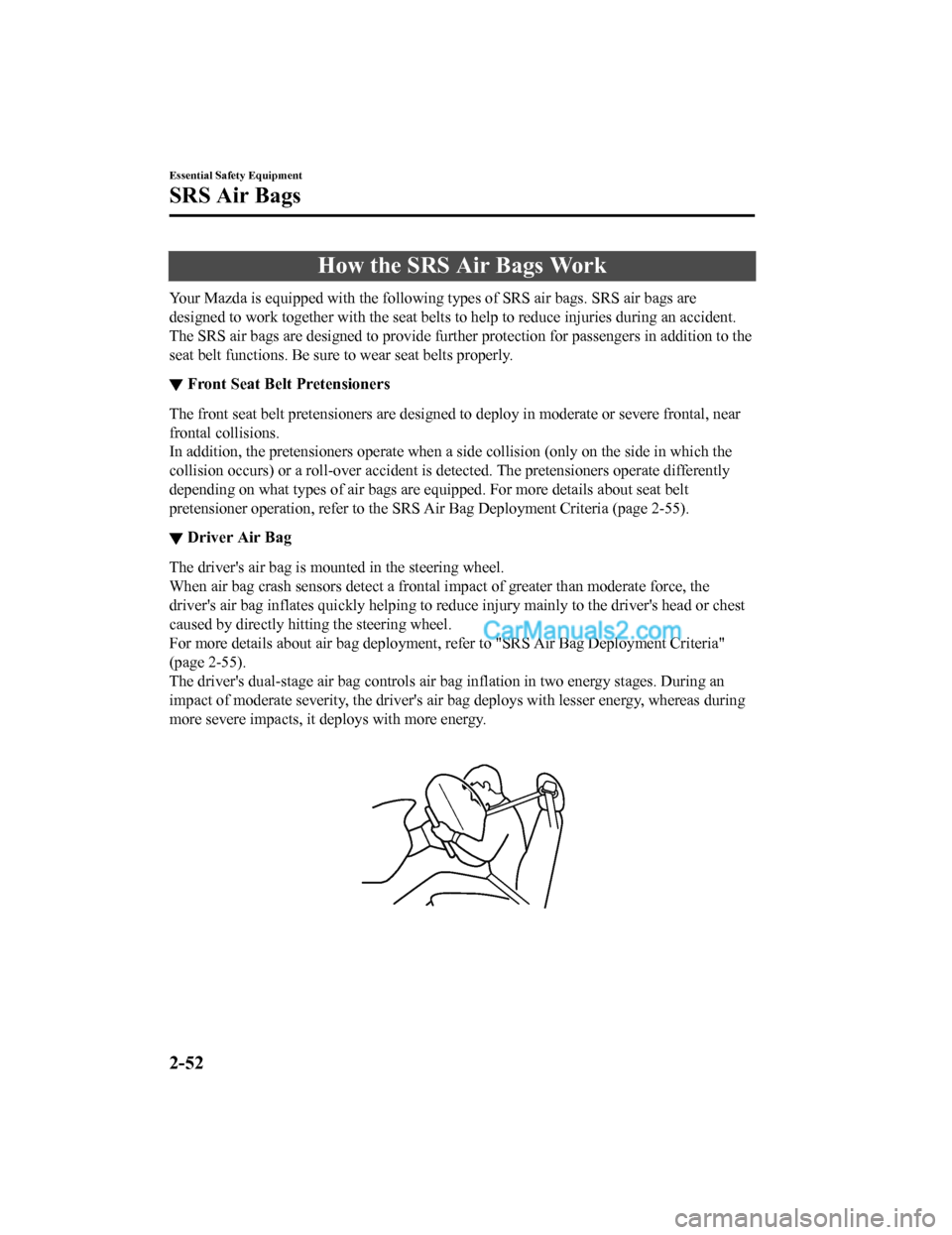
How the SRS Air Bags Work
Your Mazda is equipped with the following types of SRS air bags. SRS air bags are
designed to work together with the seat belts to help to reduce injuries during an accident.
The SRS air bags are designed to provide further protection for passengers in addition to the
seat belt functions. Be sure to wear seat belts properly.
▼ Front Seat Bel
t Pretensioners
The front seat belt pretensioners are designed to deploy in mod erate or severe frontal, near
frontal collisions.
In addition, the pretensioners o perate when a side collision (only on the side in which the
collision occurs) or a roll-over accident is detected. The pretensioners operate differently
depending on what types of air bags are equipped. For more deta ils about seat belt
pretensioner operation, refer to the SRS Air Bag Deployment Cri teria (page 2-55).
▼Driver Air Bag
The driver's air bag is mounted in the steering wheel.
When air bag crash sensors detect a frontal impact of greater than moderate force, the
driver's air bag inflates quickly helping to reduce injury main
ly to the driver's head or chest
caused by directly hitting the steering wheel.
For more details about air bag de ployment, refer to "SRS Air Bag Deployment Criteria"
(page 2-55).
The driver's dual-stage air bag controls air bag inflation in t wo energy stages. During an
impact of moderate severity, the driver's air bag deploys with lesser energy, whereas during
more severe impacts, it deploys with more energy.
Essential Safety Equipment
SRS Air Bags
2-52
CX-5_8GN5-EA-17J_Edition1 2017-8-18 12:58:27
Page 67 of 628

▼Front Passenger Air Bag
The front passenger air bag is mounted in the front passenger dashboard.
The inflation mechanism for the fr
ont passenger air bag is the same as the driver's air bag.
For more details about air bag deployment, refer to "SRS Air Ba g Deployment Criteria"
(page 2-55).
In addition, the front passenger air bag is designed to only de ploy when the front passenger
occupant classification sensor detects a passenger sitting on t he front passenger's seat. For
details, refer to the front passenger occupant classification s ystem (page 2-58).
▼Side Air Bags
The side air bags are mounted in the outboard sides of the fron
t seatbacks.
When the air bag crash sensors detect a s ide impact of greater than moderate force, the
system inflates the side air bag only on the side in which the vehicle was hit. The side air
bag inflates quickly to reduce i njury to the driver or front passenger's chest caused by
directly hitting interior parts such as a door or window.
For more details about air bag deployment, refer to "SRS Air Ba g Deployment Criteria"
(page 2-55).
In addition, the front passenger side bag is designed to only d eploy when the front passenger
occupant classification sensor detects a passenger sitting on t he front passenger's seat. For
details, refer to the front passenger occupant classification s ystem (page 2-58).
Essential Safety Equipment
SRS Air Bags
2-53
CX-5_8GN5-EA-17J_Edition1 2017-8-18 12:58:27
Page 68 of 628
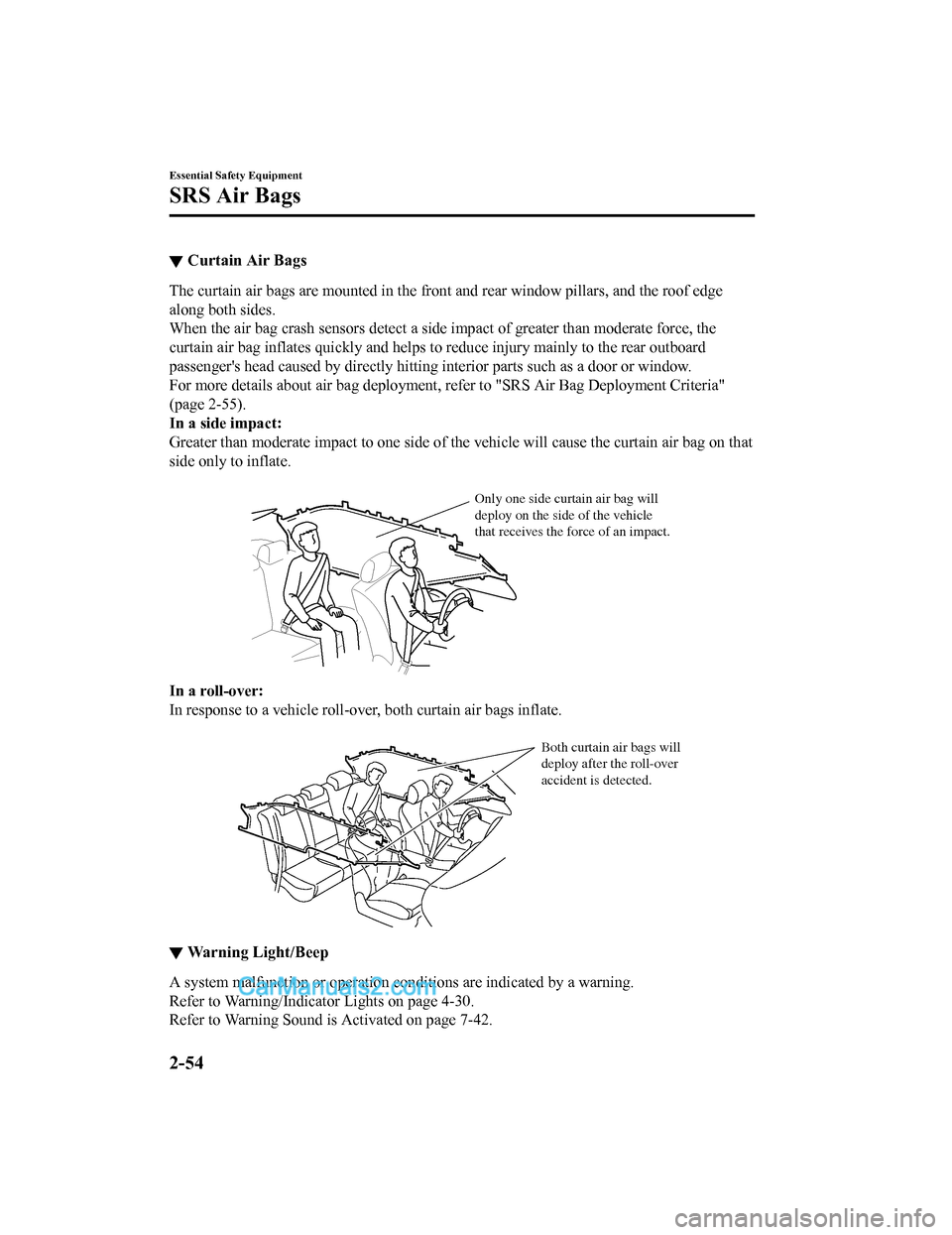
▼Curtain Air Bags
The curtain air bags are mounted in the front and rear window p
illars, and the roof edge
along both sides.
When the air bag crash sensors detect a side impact of greater than moderate force, the
curtain air bag inflates quickly and helps to reduce injury mai nly to the rear outboard
passenger's head caused by dir ectly hitting interior parts such as a door or window.
For more details about air bag de ployment, refer to "SRS Air Bag Deployment Criteria"
(page 2-55).
In a side impact:
Greater than moderate impact to o ne side of the vehicle will cause the curtain air bag on that
side only to inflate.
Only one side curtain air bag will
deploy on the side of the vehicle
that receives the force of an impact.
In a roll-over:
In response to a vehicle roll-ov er, both curtain air bags inflate.
Both curtain air bags will
deploy after the roll-over
accident is detected.
▼ Warning Light/Beep
A system malfunction or operation conditions are indicated by a
warning.
Refer to Warning/Indicator Lights on page 4-30.
Refer to Warning Sound is Activated on page 7-42.
Essential Safety Equipment
SRS Air Bags
2-54
CX-5_8GN5-EA-17J_Edition1 2017-8-18 12:58:27
Page 69 of 628

SRS Air Bag Deployment Criteria
This chart indicates the applicable SRS equipment that will deploy depending on the type of
collision.
(The illustrations are the representative cases of collisions.)
SRS equip- ment Types of collision
A severe frontal/near frontal colli- sion A severe side colli-
sion
*2A roll-over/nearroll-over*3A rear collision
Front seat
belt preten- sioner X*1 (both sides)
X*1 (impact side
only) X*1 (both sides)
No air bag and
front seat belt pre-
tensioner will be
activated in a rear
collision.
Driver air
bag X
Front pas- senger air bag X
*1
Side air bag
X*1 (impact side
only)
Curtain air bag X (impact side on-
ly) X (both sides)
X: The SRS air bag equipment is d
esigned to deploy in a collision.*1 The front passenger front and si de air bags and the seat belt pretensioner are designed to deploy when the front
passenger occupant classificati on sensor detects a passenger si tting on the front passenger's seat.
*2 In a side collision, the seat belt pretensioners and the side/ curtain air bags deploy (only on the side in which the
collision occurs).
*3 In a roll-over accident, the seat belt pretensioners and the c urtain air bags deploy.
NOTE
In a frontal offset collision, the equipped air bags and pretensioners may all deploy
depending on the direction, angle, and rate of impact.
Essential Safety Equipment
SRS Air Bags
2-55
CX-5_8GN5-EA-17J_Edition1 2017-8-18 12:58:27
Page 72 of 628
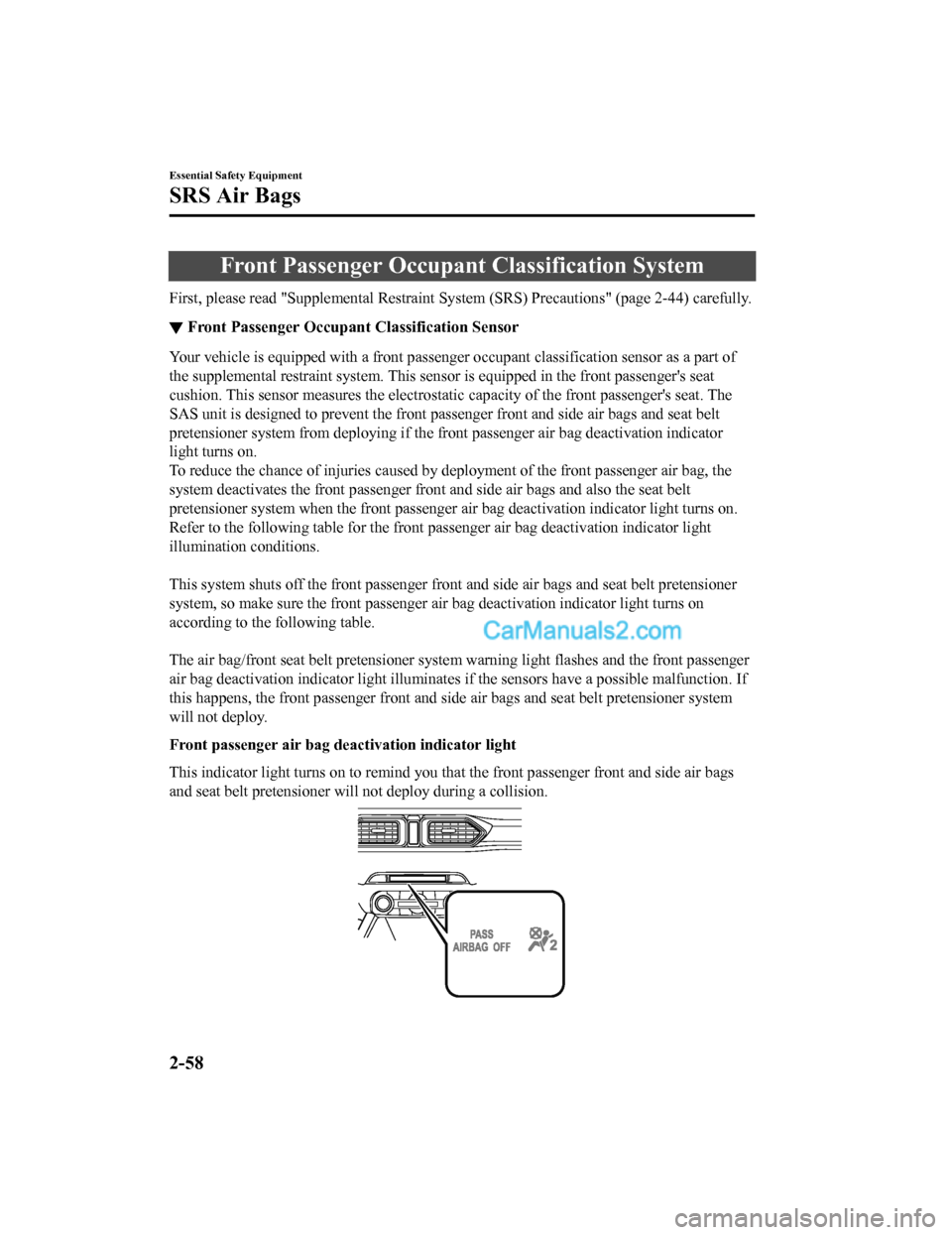
Front Passenger Occupant Classification System
First, please read "Supplemental Restraint System (SRS) Precaut ions" (page 2-44) carefully.
▼Front Passenger Occupant Classification Sensor
Your vehicle is equipped with a front passenger occupant classi
fication sensor as a part of
the supplemental restraint system. This sensor is equipped in the front passenger's seat
cushion. This sensor measures the electrostatic capacity of the front passenger's seat. The
SAS unit is designed to prevent the front passenger front and side air bags and seat belt
pretensioner system from deploying if the front passenger air b ag deactivation indicator
light turns on.
To reduce the chance of injuries caused by deployment of the fr ont passenger air bag, the
system deactivates the front passenger front and side air bags and also the seat belt
pretensioner system when the front passenger air bag deactivati on indicator light turns on.
Refer to the following table fo r the front passenger air bag de activation indicator light
illumination conditions.
This system shuts off the front passenger front and side air bags and seat belt pretensioner
system, so make sure the front passenger air bag deactivation i ndicator light turns on
according to the following table.
The air bag/front seat belt pretensioner system warning light f lashes and the front passenger
air bag deactivation indicator li ght illuminates if the sensors have a possible malfunction. If
this happens, the front passenger front and side air bags and s eat belt pretensioner system
will not deploy.
Front passenger air bag de activation indicator light
This indicator light turns on to remind you that the front pass enger front and side air bags
and seat belt pretensioner wil l not deploy during a collision.
Essential Safety Equipment
SRS Air Bags
2-58
CX-5_8GN5-EA-17J_Edition1 2017-8-18 12:58:27
Page 73 of 628
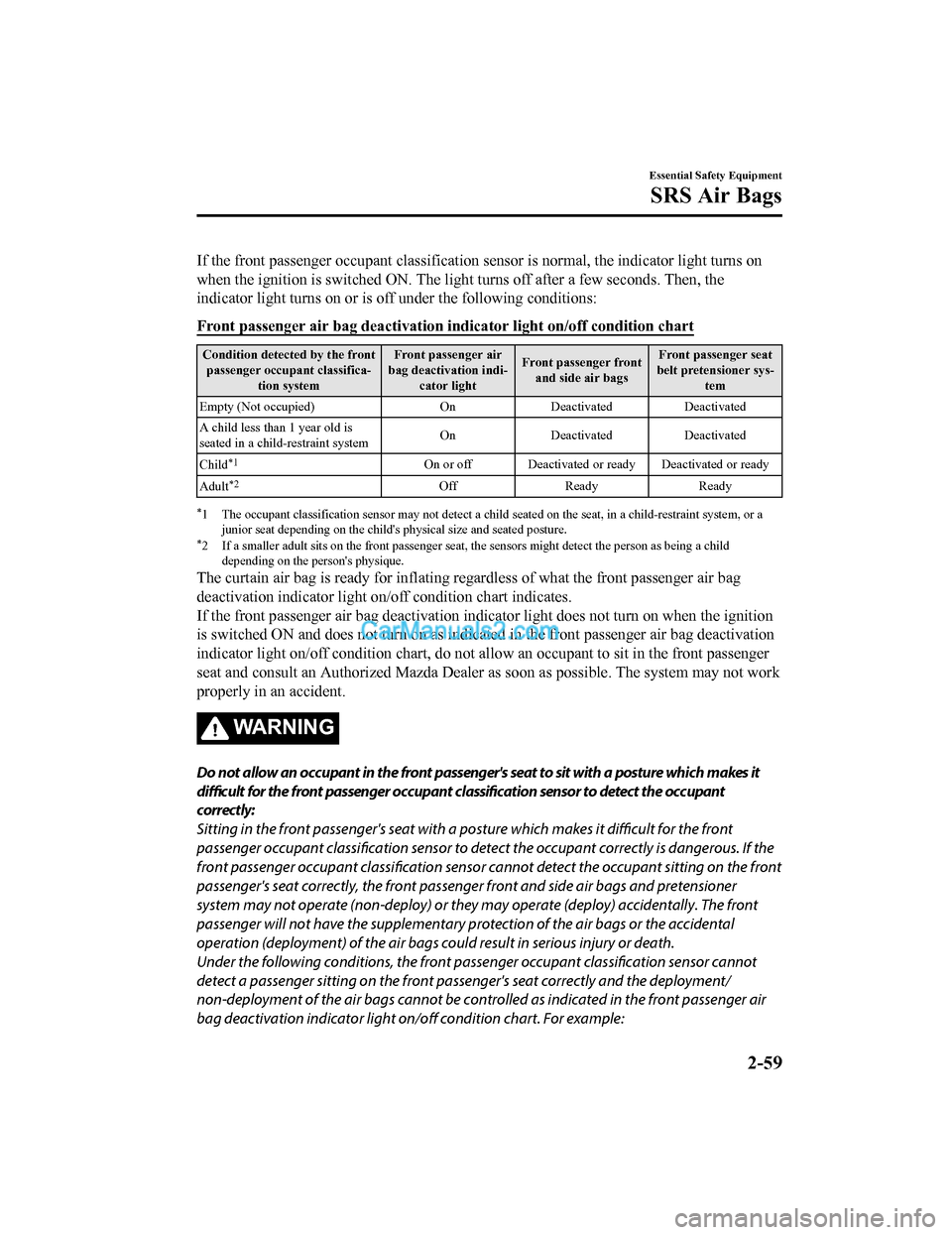
If the front passenger occupant classification sensor is normal, the indicator light turns on
when the ignition is switched ON. The light turns off after a f ew seconds. Then, the
indicator light turns on or is off under the following conditio ns:
Front passenger air bag deactivation indicator light on/off con dition chart
Condition detected by the front
passenger occupant classifica- tion system Front passenger air
bag deactivation indi- cator light Front passenger front
and side air bags Front passenger seat
belt pretensioner sys- tem
Empty (Not occupied) OnDeactivated Deactivated
A child less than 1 year old is
seated in a child-restraint system On
Deactivated Deactivated
Child
*1On or off Deactivated or ready Deactivated or ready
Adult
*2Off Ready Ready
*1 The occupant classification sensor may not detect a child seat ed on the seat, in a child-restraint system, or a
junior seat depending on the ch ild's physical size and seated posture.
*2 If a smaller adult sits on the front passenger seat, the sensors might detect the person as being a child
depending on the person's physique.
The curtain air bag is ready for inflating regardless of what the front passenger air bag
deactivation indicator light on/ off condition chart indicates.
If the front passenger air bag d eactivation indicator light does not turn on when the ignition
is switched ON and does not turn on as indicated in the front p assenger air bag deactivation
indicator light on/off condition chart, do not allow an occupan t to sit in the front passenger
seat and consult an Authorized Mazda Dealer as soon as possible . The system may not work
properly in an accident.
WA R N I N G
Do not allow an occupant in the front passenger's seat to sit with a posture which makes it
difficult for the front passenger occupant classification sensor to detect the occupant
correctly:
Sitting in the front passenger's seat with a posture which makes it difficult for the front
passenger occupant classification sensor to dete ct the occupant correctly is dangerous. If the
front passenger occupant classification sensor ca nnot detect the occupant sitting on the front
passenger's seat correctly, the front passeng er front and side air bags and pretensioner
system may not operate (non-deploy) or they may operate (deploy) accidentally. The front
passenger will not have the supplementary prot ection of the air bags or the accidental
operation (deployment) of the air bags could result in serious injury or death.
Under the following conditions, the front passenger occupant classification sensor cannot
detect a passenger sitting on the front passenger's seat correctly and the deployment/
non-deployment of the air bags cannot be controlled as indicated in the front passenger air
bag deactivation indicator light on/off condition chart. For example:
Essential Safety Equipment
SRS Air Bags
2-59
CX-5_8GN5-EA-17J_Edition1 2017-8-18 12:58:27
Page 75 of 628
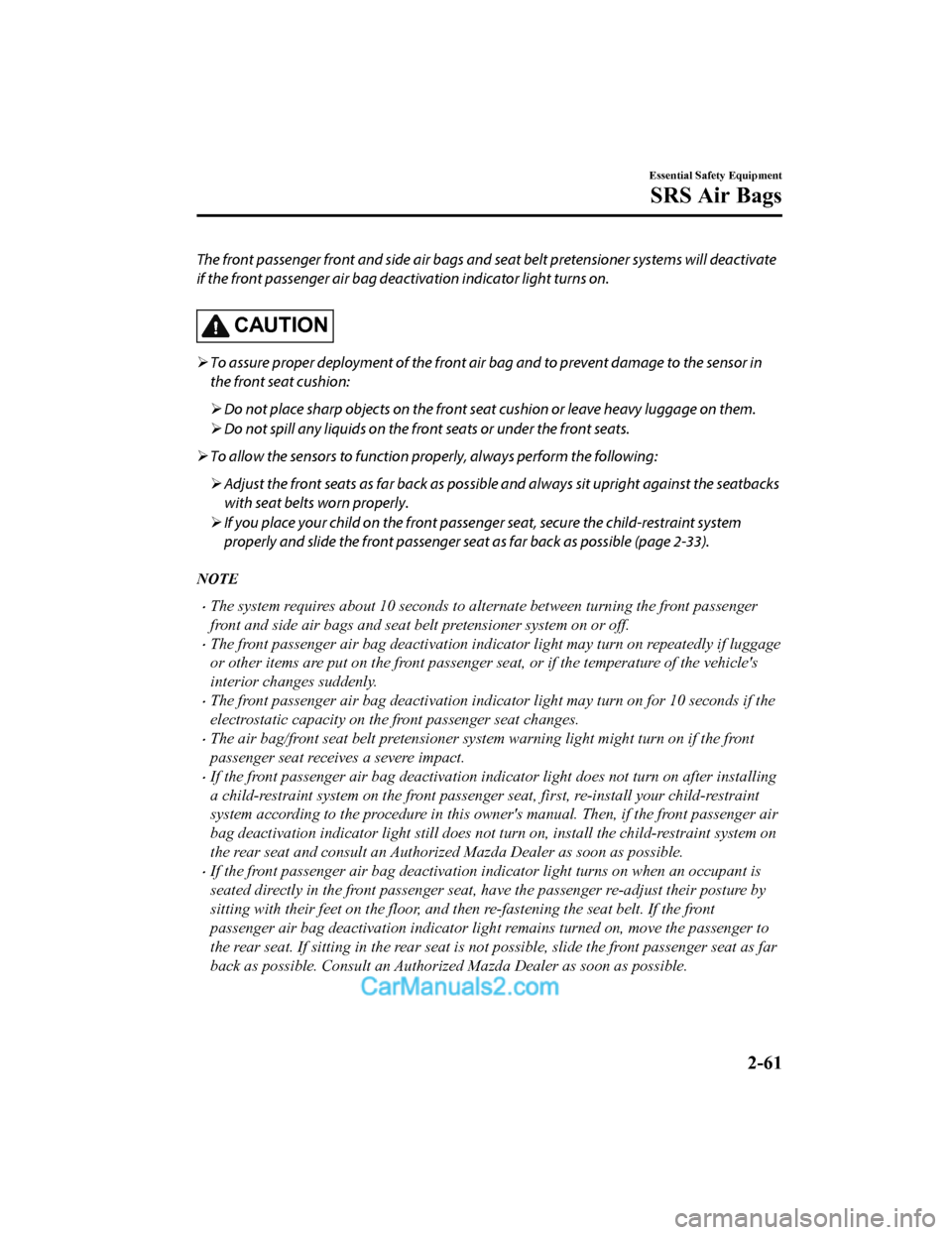
The front passenger front and side air bags and seat belt pretensioner systems will deactivate
if the front passenger air bag deactivation indicator light turns on.
CAUTION
To assure proper deployment of the front air bag and to prevent damage to the sensor in
the front seat cushion:
Do not place sharp objects on the front seat cushion or leave heavy luggage on them.
Do not spill any liquids on the fr ont seats or under the front seats.
To allow the sensors to function pr operly, always perform the following:
Adjust the front seats as far back as possibl e and always sit upright against the seatbacks
with seat belts worn properly.
If you place your child on the front passe nger seat, secure the child-restraint system
properly and slide the front passenger seat as far back as possible (page 2-33).
NOTE
•The system requires about 10 seconds to alternate between turning the front passenger
front and side air bags and seat belt pretensioner system on or off.
•The front passenger air bag deactivation indicator light may turn on repeatedly if luggage
or other items are put on the front passenger se at, or if the temperature of the vehicle's
interior changes suddenly.
•The front passenger air bag deactivation indicator light may turn on for 10 seconds if the
electrostatic capacity on the front passenger seat changes.
•The air bag/front seat belt pr etensioner system warning light might turn on if the front
passenger seat receives a severe impact.
•If the front passenger air bag deactivation indicator light does not turn on after installing
a child-restraint system on the front passenger seat, first, re-install your child-restraint
system according to the procedure in this owner's manual. Then, if the front passenger air
bag deactivation indicator light still does not turn on, install the child-restraint system on
the rear seat and consult an Authorized Mazda Dealer as soon as possible.
•If the front passenger air bag deactivation indicator light turns on when an occupant is
seated directly in the front passenger seat , have the passenger re-adjust their posture by
sitting with their feet on the floor, and then re-fastening the seat belt. If the front
passenger air bag deactivation indicator light remains turned on, move the passenger to
the rear seat. If sitting in the rear seat is not possible, slide the front passenger seat as far
back as possible. Consult an Authorized Mazda Dealer as soon as possible.
Essential Safety Equipment
SRS Air Bags
2-61
CX-5_8GN5-EA-17J_Edition1 2017-8-18 12:58:27
Page 76 of 628
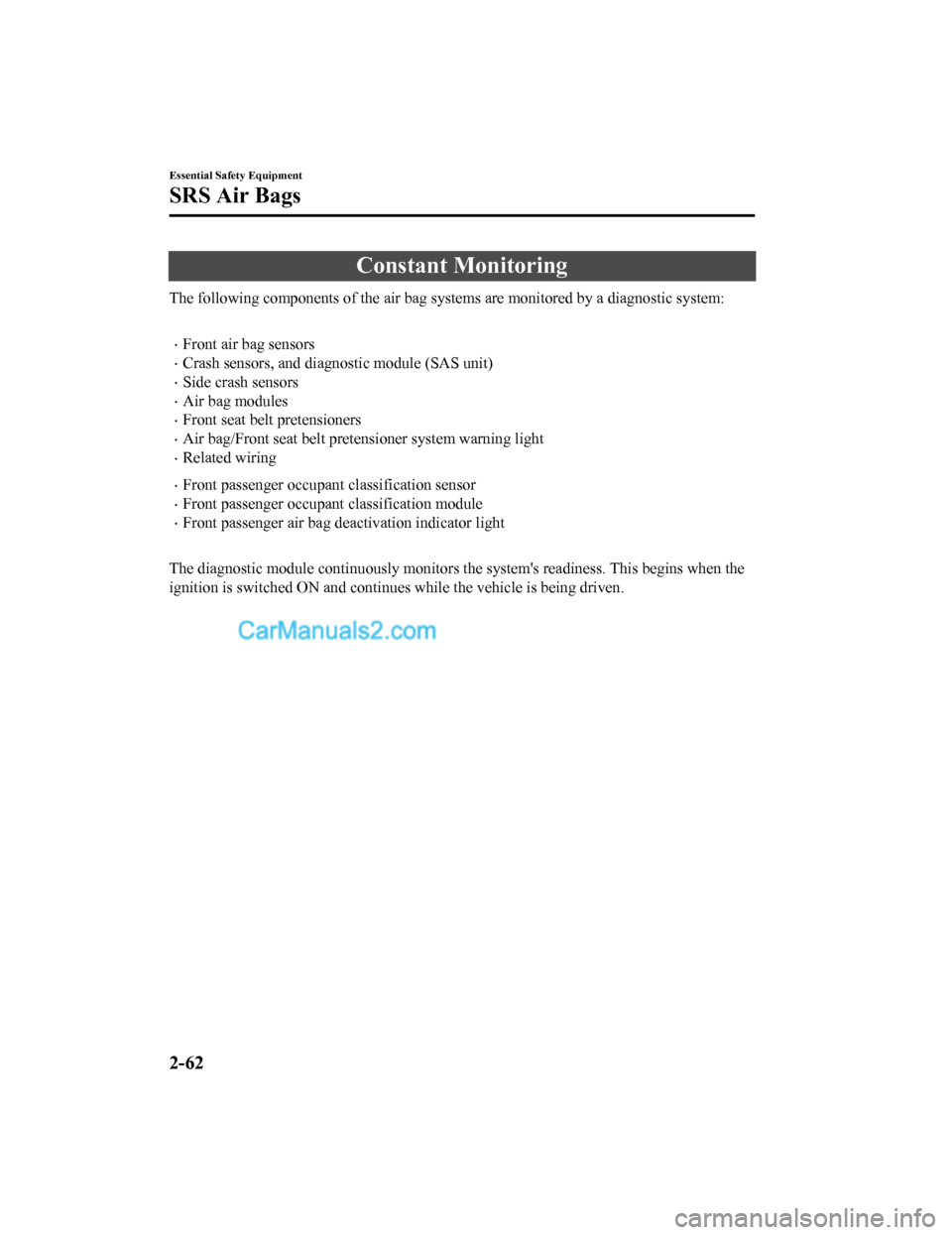
Constant Monitoring
The following components of the air bag systems are monitored by a diagnostic system:
•Front air bag sensors
•Crash sensors, and diagnostic module (SAS unit)
•Side crash sensors
•Air bag modules
•Front seat belt pretensioners
•Air bag/Front seat belt pret ensioner system warning light
•Related wiring
•Front passenger occupant classification sensor
•Front passenger occupant classification module
•Front passenger air bag deactivation indicator light
The diagnostic module continuously monitors the system's readiness. This begins when the
ignition is switched ON and continues while the vehicle is bein g driven.
Essential Safety Equipment
SRS Air Bags
2-62
CX-5_8GN5-EA-17J_Edition1 2017-8-18 12:58:27
Page 102 of 628

Changing the power liftgate fully open
position
The power liftgate fully-open position can
be changed according to the height of a
garage.
When changing the position
1. Stop the liftgate at the desired position.
2. Press the power liftgate close switchfor about three seconds.
A beep sound is activated two times to
indicate that the position change has
been completed.
NOTE
Set the desired fully-open position of the
liftgate at the position where it is open
more than halfway. The position where it
is less than halfway open cannot be set.
To r e s e t
1. Open the liftgate.
2. Press the power liftgate close switchfor about seven seconds.
A beep sound is activated three times
to indicated that the reset has been
completed.
NOTE
After about 3 seconds have elapsed since
the switch was pressed, a beep sound is
activated 2 times to indicate that the
liftgate fully-open position has changed.
Continuously press the switch for about 7
seconds to complete the reset.
Jam-safe equipment
While the power li ftgate is opening/
closing electrically and the system detects
a person or an object in the liftgate's path,
the liftgate will move in the reverse
direction automatically and stops.
WA R N I N G
Always check the area around the power
liftgate before opening/closing it:
Not checking for occupants and objects
around the power liftgate before opening/
closing it is dangerous. The jam-safe
equipment is designed to prevent jamming
in the event an obstruction is in the
liftgate's path. The system may not detect
certain objects obstructing the liftgate
depending on the way they are positioned
and their shape. However, if the jam-safe
function detects an obstruction and moves
the liftgate in the reverse direction, an
occupant in the liftgate's path could be
seriously injured.
CAUTION
Sensors are installed on both ends of the
power liftgate. Be careful not to allow the
sensors to be scratched or damaged by
sharp objects, otherwise the liftgate may
no longer open/close automatically. In
addition, if the sensor is damaged while the
liftgate is closing automatically, the system
will stop.
Sensor
Before Driving
Doors and Locks
3-26
CX-5_8GN5-EA-17J_Edition1 2017-8-18 12:58:27
Page 104 of 628

Fuel and Engine Exhaust Precautions
▼Fuel Requirements
Vehicles with catalytic converters or oxygen sensors must use O
NLY UNLEADED FUEL,
which will reduce exhaust emissions and keep spark plug fouling to a minimum.
This vehicle will per form best with fuel listed in the table.
Fuel
Octane Rating* (Anti-knock index)
Regular unleaded fuel 87 [(R
M)/2 method] or above (91 RON or above)
∗U.S. federal law requires that
octane ratings be posted on gaso line station pumps.
Fuel with a rating lower than 87 octane (91 RON) will negatively affect the emission control
system performance and could also cause engine knocking and ser ious engine damage.
CAUTION
USE ONLY UNLEADED FUEL.
Leaded fuel is harmful to the catalytic co nverter and oxygen sensors and will lead to
deterioration of the emission control system and or failures.
This vehicle can only use oxygenated fuels containing no more than 10 % ethanol by
volume. Damage to the vehicle may occur when ethanol exceeds this recommendation, or
if the gasoline contains any methanol. Stop using gasohol of any kind if your vehicle engine
is performing poorly.
Never add fuel system additives, otherwise the emission control system could be damaged.
Consult an Authorized Mazda Dealer for details.
Gasoline blended with oxygenates such as alcohol or ether compo unds are generally
referred to as oxygenated fuels. The common gasoline blend that can be used with your
vehicle is ethanol blended at no more than 10 %. Gasoline conta ining alcohol, such as
ethanol or methanol, may be marketed under the name "Gasohol".
Vehicle damage and drivability pr oblems resulting from the use of the following may not be
covered by the warranty.
•Gasohol containing more than 10 % ethanol.
•Gasoline or gasohol containing methanol.
•Leaded fuel or leaded gasohol.
Before Driving
Fuel and Emission
3-28
CX-5_8GN5-EA-17J_Edition1 2017-8-18 12:58:27